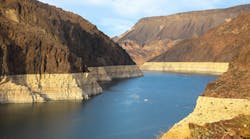Piloting Pollution Prevention
Located 20 miles east of Seattle, the city of Redmond, Wash., is home to 50,000 residents and many high-tech and biomedical companies. Redmond’s downtown drainage area is dominated by commercial, industrial and roadway areas with typical surface pavement contaminants such as metals, nutrients and sediment.
Redmond’s storm water flows into the Sammamish River and Lake Sammamish, important water bodies for rearing and migrating salmon species. To help prevent runoff from harming these waterways, the city developed stringent storm water regulations and sought a permanent storm water treatment system that exceeded existing environmental guidelines.
Testing Solutions
The city selected Water Tectonics as the vendor to supply the permanent storm water treatment system at the new McRedmond Regional Water Quality Facility (RWQF),located on a 15.5-acre site in downtown Redmond. This system is a pilot study and part of a $40-million, multiphased citywide storm water infrastructure improvement program.
Water Tectonics, in conjunction with Royal Environmental Systems, designed a system to remove total and dissolved metals, phosphorus and suspended sediment. The end product is one of the first of its kind in the country and is currently being monitored as part of a long-term evaluation study.
The McRedmond RWQF incorporates two storm water treatment technologies: ecoStorm, a gross particle separator, and ecoStorm plus, a storm water filtration system installed in series to form a treatment train.
Storm water initially flows into the gross particle separator, where more than 80 percent of floating pollutants, settled solids and litter are removed. The separator is designed to remove more than 80 percent of gross particulates. Effluent is then sent to a splitter manhole to be distributed into four pipes that lead to four storm water filtration units.
Sediment is further removed from the storm water by gravitation using a hydrodynamic separator. This occurs before the storm water flows upward through the storm water filtration units, where most of the remaining total suspended solids, metals and phosphorus are removed through chemical transformation, precipitation and sorption. The treated storm water effluent flows from the storm water filtration units to the Sammamish River.
At the city’s request, the McRedmond RWQF system was oversized by a factor of two to study performance using a slower treatment rate to meet standards for groundwater infiltration within a wellhead protection area. The system far exceeds the 1.3-cu-ft-per-second facility treatment requirement. Four storm water filtration units typically treat up to 3.2 cu ft per second.
Measuring Effectiveness
During a two-year study, the treatment facility’s performance will be evaluated through online monitoring of rainfall, flow and turbidity using real-time remote monitoring capabilities. Rainfall and flow will also trigger flow-weighted autosampling to capture representative composite samples from individual storm events.
Three autosamplers will collect samples upstream and downstream from the units. The autosamplers are programmed to collect composite samples from events that meet the minimum requirements of a qualifying storm event. Sampling lines and cables are routed to a monitoring trailer through permanent conduit. The monitoring trailer contains all autosamplers and online monitoring equipment.
Monitored parameters include total and dissolved metals, hydrocarbons, total phosphorus, orthophosphate and particle size distribution. The sampling design also includes online monitoring of bypass flows and turbidity at the three sampling locations.
This long-term monitoring is expected to provide a clear understanding of the effectiveness of the gross particle separator and the storm water filtration treatment systems and will serve as a model for future water quality treatment facilities.
Download: Here

